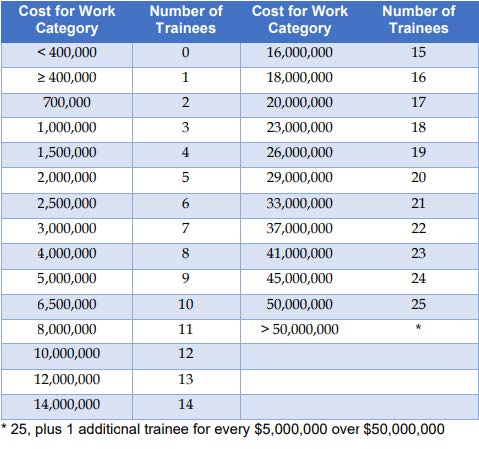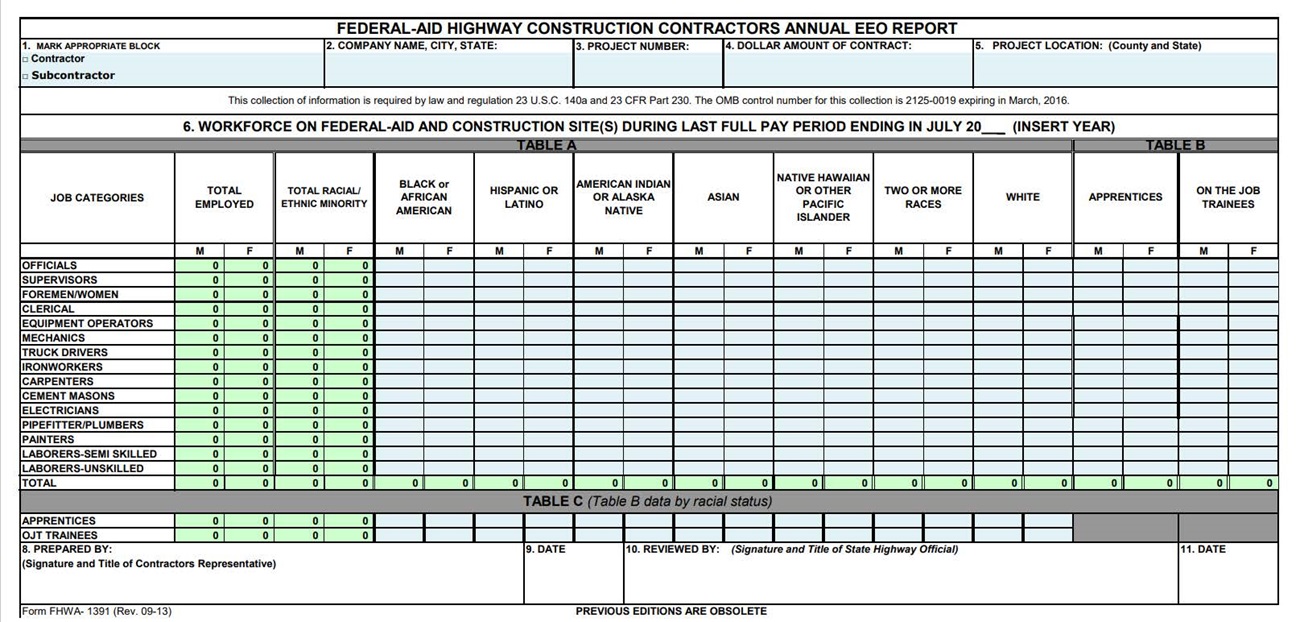Chapter 12: Federal Trainee Requirements
- 12-1 Introduction
- 12-2 Roles and Responsibilities
- 12-3 Federal Trainee Registration
- 12-4 Federal Trainee Schedule
- 12-5 Reimbursement
12-1 Introduction
Caltrans has established a federal On-the-Job Training (OJT) program in accordance with regulation 23 CFR Part 230, Subpart A, “Equal Employment Opportunity on Federal and Federal-aid Construction Contracts.” Certain federal-aid highway construction contracts and subcontracts require that the federal trainee or OJT special provisions be included in the contract.
The federal OJT program provides opportunities for women, minorities, and disadvantaged individuals to enter into journey-level positions and to help bolster a competent workforce to meet the needs of construction hiring, and to include historically underrepresented groups in highway construction projects.
Primary Objectives for Training Programs:
- Provide training in public works jobs in construction for women and minorities, to provide them with new job skills, thereby increasing their access to higher paying trade jobs and journeyperson-level positions.
- Encourage building a diverse workforce to meet future labor needs in the construction industry.
12-1-1 On-the-Job Training Program Components
Contracts must show the number of trainees, the number of trainees upgraded to journeyperson, and the level of skills.
The local agency must review the training programs proposed by contractors. Approval or rejection is based on the legitimacy of the job-skill classifications proposed and the number of training hours specified.
Caltrans must determine if statewide OJT is effective. The contractor is responsible for recruitment and selection of trainees.
Required trainees or apprentices are to be funded on the bidding schedule or by change order at $0.80 an hour, or the training program can be a bid item with the same reimbursement ratio as the construction project. OJT support services include recruiting, counseling, remedial training, and an OJT program administered by others.
If the contractor does not show a good faith effort to provide acceptable training to the trainees specified, a sanction may be applied. Sanctions may include withholding progress payments if effective on-the-job training is not provided.
12-2 Roles and Responsibilities
Figure 12-A, “On-the-Job Training Roles and Responsibilities,” lists the requirements of each party of a contract.
FIGURE 12‑A: ON-THE-JOB TRAINING ROLES AND RESPONSIBILITIES
|
RESPONSIBILITY ASSIGNMENT |
DUTIES |
|
Caltrans |
|
|
Contractor |
|
|
Apprentice-Trainee |
|
12-3 Federal Trainee Registration
A trainee under the federal definition is an apprentice employed by a contractor who is registered in a formal training program governed by an apprenticeship committee. Apprentices and trainees are allowed to work for less than the prevailing wage rate under Form FHWA-1273 if they are registered in a bona fide apprenticeship program.
Additionally, the journeyperson-to-apprentice ratios must be met. The ratio of journeyperson to apprentices is generally 5 to 1, as specified for each trade. If the proper ratios are not met in the field, the worker must be paid as a journeyperson and not as an apprentice.
Apprentices lacking evidence of registration, and apprentices in excess of allowable ratios must be paid the federal journeyperson prevailing wage rate. If the contractor pays a worker apprentice wages, without having submitted proof of registration, payment should be withheld unless the contractor provides a correction to the payroll or proof of registration.
The Department of Labor (DOL) does not publish federal apprentice rates. When an apprentice is properly registered in a federally recognized apprentice program, the contractor may pay the applicable state apprentice rate as published by Department of Industrial Relations (DIR).
Before starting work, the contractor must submit a training plan to the resident engineer for approval. The specifications that require the contractor to have a training plan or OJT program are in The Required Federal-Aid Contract Language FHWA-1273 in the special provisions. The plan must include the following information:
- Number of apprentices for each classification
- Apprentice program to be used
- Starting date for each classification
12-4 Federal Trainee Schedule
Federal trainees are considered registered apprentices. For federally funded projects with at least 100 working days, trainee funds are required for each of the following work categories:
- Earthwork, except imported borrow
- Pile driving
- Portland cement concrete, except precast concrete
- Masonry
- Bar reinforcing and prestressing steel
- Structural steel erection
- Electrical
- Buildings
If the totals for each of the work categories listed are all less than $400,000 then no trainees and no Federal Trainee Program special provisions are required.
The number of federal trainees required for the contract is the sum of estimated cost of work for each work categories. Once that number is determined, Table 12-B, “Federal Trainees Required,” is used to determine the number of trainees in that category.
TABLE 12‑B: FEDERAL TRAINEES REQUIRED

When a contractor fails to meet the federal training requirements, the contractors must show a good faith effort by documenting recruitment efforts to obtain trainees. Otherwise, sanctions, such as withholding progress payments, may be applied. Figure 12-C, “Federal Training Schedule,” is an example of documentation required from contractors.
FIGURE 12‑C: FEDERAL TRAINING SCHEDULE

12-5 Reimbursement
Reimbursement can be made for all apprentices used on the projects without regard to the number of apprentices listed for the goal or the number of hours used. The trainees must be registered in a bona fide federal apprenticeship program.
The contractor must provide periodic reports documenting their performance under this training special provision to the resident engineer and verify the apprentice hours on the payroll against the hours listed on the extra work bill. The contractor can submit one extra work bill at the end of the project for reimbursement or submit the extra work bills semi-annually.
In order for a contractor to be reimbursed the $0.80 per hour for each trainee, the resident engineer must write a change order for the hours claimed. The state approved apprentices can be on the prime or subcontractor’s payroll.
Labor Compliance Manual Chapters
Chapter 1 - History, Laws and Regulations Governing Prevailing Wage Requirements
Chapter 2 - Governing Agencies
Chapter 3 - Caltrans Labor Compliance Program and Related Requirements
Chapter 4A - Division of Construction-Administered Contracts
Chapter 4B - Other Division-Administered Contracts
Chapter 5 - State Wage Determination
Chapter 6 - Federal Wage Determinations
Chapter 7 - Labor Compliance File
Chapter 8 - Pre-Job Conference Requirements and Posters
Chapter 9 - Determining Prevailing Wage Covered Work
Chapter 10 - Classification of Labor and Required Rates of Pay
Chapter 11 - Apprentice Requirements
Chapter 12 - Federal Trainee Requirements
Chapter 13 - Weekly Certified Payroll Records
Chapter 15 - Payroll Review and Confirmation
Chapter 17 - Notification Process
Chapter 18 - Employee Interviews and Equal Employment Opportunity (EEO) Compliance
Chapter 19 - Complaints Process
Chapter 20 - Audits and Investigations Process
Chapter 21 - Wage Case Submittal
Chapter 22 - Restitution Collection

